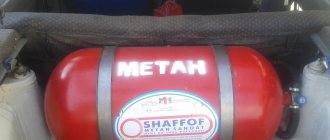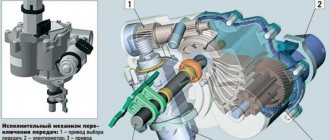Lada Vesta CNG is a modification that allows the use of two types of fuel: compressed natural gas (methane) and gasoline. One of the main advantages of this version is cost-effectiveness. We decided to find out what the real fuel consumption and range of the Lada Vesta with LPG is.
It is worth noting that when using gas, the system still consumes gasoline. This was done to reduce the combustion temperature of the mixture, which reduces the thermal effect on the engine when using gas. According to rough estimates, gasoline consumption is 1-1.5 l/100 km.
Fuel consumption from technical specifications
:
- Urban cycle, l/100 km — 10.1
- Urban cycle, m3/100 km - 8.1
- Extra-urban cycle, l/100 km — 6.0
- Extra-urban cycle, m3/100 km - 5.2
- Combined cycle, l/100 km - 7.5
- Combined cycle, m3/100 km - 6.3
Specifications
| Characteristic | 1.6 MT |
| Engine's type: | Dual fuel methane and gasoline |
| Engine capacity: | 1596 |
| Power: | 106 hp |
| Acceleration to 100 km/h: | 11.8 s |
| Maximum speed: | 177 km/h |
| Consumption in the urban cycle: | 10.1/100km |
| Extra-urban consumption: | 6.0/100km |
| Combined cycle consumption: | 7.5/100km |
| Fuel tank capacity: | 55 l |
| Length: | 4410 mm |
| Width: | 1764 mm |
| Height: | 1497 mm |
| Wheelbase: | 2635 mm |
| Clearance: | 185 mm |
| Weight: | 1670 kg |
| Trunk volume: | 250 l |
| Transmission: | 5-speed manual |
| Drive unit: | Front |
| Front suspension: | Independent, MacPherson type, spring, with hydraulic or gas-filled telescopic shock absorbers, with anti-roll bar |
| Rear suspension: | Semi-independent, lever, spring, with hydraulic or gas-filled telescopic shock absorbers |
| Front brakes: | Disk |
| Rear brakes: | Drums |
| Production: | Tolyatti |
Dimensions of Lada Vesta CNG
- length - 4.410 m;
- width - 1.764 m;
- height - 1.497 m;
- wheelbase - 2.6 m;
- ground clearance - 185 mm;
- trunk volume - 250 l.
How does gas Vesta work?
A Vesta bifuel cylinder holds 90 liters, which corresponds to 21–22 cubic meters of gas (the exact volume value is determined by the density of the gas and the pressure in the filling column). The working pressure in the cylinder is 20 MPa at 15°C, and the test pressure reaches 30 MPa. Operating temperature range - from -40 to 55°C.
On a full gas charge, you can travel 300–400 km, and it will cost three times less than with gasoline. And since the 55-liter gas tank remained untouched, Vesta CNG can cover more than a thousand kilometers at one refueling with both types of fuel.
The possibilities for transforming the interior have been reduced to a minimum, but this Vesta travels 1000 kilometers without refueling.
The cylinder ate up a fair share of the usable space of the 480-liter trunk. From it to the rear wall of the luggage compartment no more than five 1.5-liter bottles of mineral water will fit. This (based on the fact that the bottle diameter is 92 mm) is only 460 mm. A regular petrol Vesta has a trunk depth of 920 mm - twice as much. There is also almost no space left above the cylinder - well, you can squeeze in a couple of flat bags. By eye, the actual volume of the trunk has been reduced by almost half (there are no exact factory data yet).
A Chinese 90-liter cylinder holds 18–21 cubic meters. m of gas. Alas, its installation reduced the depth of the trunk by half.
The false floor covering the spare tire has also become half as long. Below that is a new tool tray that wraps around the spare tire, which is partially hidden by the cylinder. It's not scary: getting the spare tire is not much more difficult.
The steel gas pipeline is laid under the bottom and is not covered with anything from below - however, like the gasoline line. The gas pipeline goes under the hood to the receiver, which reduces the pressure and sends the gas further into the ramp, from where it is distributed to the injectors. Under the hood, on the left in the direction of travel, there is a controller that, in case of any unregulated gas consumption, shuts off its supply.
Metal composite cylinder - Chinese manufacturer Sinoma. They say it turned out to be the best in strength. Its guaranteed service life is 15 years, subject to re-examination every five years. The cylinder is clearly visible from the cabin when any part of the rear seat back is reclined - in fact, it blocked the entire opening, so it is now impossible to transport large loads. The valve is accessible from the passenger compartment: it must be closed if the machine is not used for a long period of time. The rest of the gas equipment is from the Italian company Emer.
The trunk area now looks like this. An empty plastic container rattles as it goes.
The filling nipple is hidden under the gas tank flap next to the gasoline filler neck. Any Gazprom CNG filling station will give you an adapter that needs to be snapped onto the fitting. The adapters are mostly Western-made, but we have our own - Russian, more compact, but a little more difficult to use: before snapping it onto the fitting, it must be unscrewed. But in general, the refueling process is simple with any adapter: you need to snap it onto the fitting and insert the gun into it. I gave the money to the cash register and the gas started flowing.
Fully pumping a Vesta cylinder, in theory, takes 10 minutes, but we did it faster - it all depends on the pressure in the column.
Lada Vesta TsNG configuration
| Equipment | Volume | Power | Consumption (city) | Consumption (highway) | checkpoint | Drive unit |
| Classic 2WD | 1.6 l | 106 hp | 10.1 | 6.0 | 5 MT | 2WD |
| Comfort 2WD | 1.6 l | 106 hp | 10.1 | 6.0 | 5 MT | 2WD |
| Luxe 2WD | 1.6 l | 106 hp | 10.1 | 6.0 | 5 MT | 2WD |
| Luxe Multimedia 2WD | 1.6 l | 106 hp | 10.1 | 6.0 | 5 MT | 2WD |
Prices and modifications of Lada Vesta on methane
At the present stage, the methane Lada Vesta is available in the following trim levels:
Comfort – manufacturers have added a number of additional functions to the basic configuration: expanded ability to adjust the driver’s seat, parking sensors, and a fairly powerful audio system. The price of the modification is about 640 thousand rubles.
The Luxe version includes power windows for the rear windows, additional side airbags, and sensors that respond to light and rain. Among other things, the version is equipped with alloy wheels with a diameter of 16 inches. For this modification, manufacturers ask from 700 thousand rubles.
Luxe Multimedia is the most expensive modification (from 730 thousand rubles). This version is equipped with a built-in navigation system, a 7-inch touch screen, six high-quality speakers, and multifunction steering.
Test drive Lada Vesta CNG - video
Advantages and disadvantages of Lada Vesta CNG
Based on test drives and reviews of Vesta CNG, we will highlight the main advantages of the model:
Let us highlight the main advantages of the model:
- reasonable price;
- the ability to work on both gas and gasoline;
- unpretentiousness to fuel quality;
- efficiency;
- attractive appearance;
- spacious salon.
The disadvantages include:
- methane gas stations are not available everywhere;
- small trunk;
- no heated steering wheel;
- the steering wheel slightly overlaps the dashboard;
- cheap interior finishing materials.
When and how much?
Serial bi-fuel Vestas with a 1.6‑liter VAZ‑21129 engine and a 5-speed JR5 manual transmission will be aimed mainly at taxi work. Dealers have already started accepting orders. Several machines were handed over to potential customers for trial operation. It is planned to make about 600 cars this year; they will be sent to “various commercial structures” in the Moscow region and Tatarstan.
If the regular Vesta 1.6 in the Classic + Start version costs 570,900 rubles, then the CNG version will cost 600,900 rubles. Meanwhile, re-equipping a car at the factory costs 170,000 rubles! Of these costs, the state compensates the manufacturer for 140,000 rubles, so the end consumer overpays only 30,000 rubles, which can be “recovered” quite quickly with active use.
Vesta CNG Comfort is priced at 628,900 rubles, Vesta CNG Lux - at 691,900, and Vesta CNG Luxe + MMS - at 715,900 rubles.
The market is eagerly awaiting the bi-fuel Largus CNG, which is often used for commercial transportation, but it will only arrive next year.
Representatives of the REGNUM news agency were among the first to test drive the Lada Vesta, which runs on both gasoline and methane gas. What changes have been made to the design of the LADA Vesta CNG, how convenient it is to use gas equipment, what is the difference in maintenance of a regular Vesta and the methane version - read this and much more in the LADA Vesta CNG test drive from REGNUM news agency.
Lada Vesta CNG was presented at the International Gas Forum in St. Petersburg in the fall of 2015. During this time, little information appeared about the new model. These were one-time occasions dedicated to exhibitions, scientific conferences or demonstrations of a gas car to government members. Brand representatives wanted to gain support at the legislative level. After all, without subsidies from the state, there was no point in a car designed to save fuel, but with a price tag higher by 80,000 rubles. But high-quality gas equipment, its installation and registration of all necessary documents cost approximately this amount.
All the differences between the simple Vesta and the dual-fuel version are due precisely to the presence of an additional source of fuel. In this material we will touch only on the gas component, leaving aside already known facts about the car itself.
The only thing that outwardly demonstrates that this car is involved in the use of alternative fuels is the nameplate on the trunk lid, the gas supply button on the front panel and the reduced luggage compartment.
It is worth saying that Vesta has a very large trunk (480 liters). The cylinder for refilling with methane is located exactly there and is attached behind the back of the second row of seats. Has the car lost useful luggage space? Yes, I lost it. Purely visually, the loss amounts to up to a third of the total volume. Is this critical? For some, perhaps. But the remaining space is enough for the luggage of three passengers.
For reinsurers and those who are afraid of everything gas, let me remind you that the car is refueled with compressed natural gas, which in the event of a leak does not accumulate in cavities and does not spread on the asphalt, but evaporates. The cylinder is designed for a working pressure of 20 MPa, and the test pressure is 30 MPa. You can fill it with up to 22 cubic meters of gas. The figure is approximate, since the volume of injected gas depends on the ambient temperature, on the density of the gas itself sold at the CNG filling station and on the operating pressure of the dispenser. If we talk about the passport data, and they are not a secret, then the volume of the cylinder is 90 liters. Operating temperature - from -45 degrees to +65. Gas equipment Emer (Italy). Metal-plastic cylinder made in China.
On one full refueling (gasoline + gas) you can travel about 1000 kilometers. If the methane tank is empty, the system automatically switches consumption to gasoline. No manipulation is required, although manual switching is also provided. The button is located on the front panel, under the radio control unit. The switch contains an indication of the volume of available gas. These are five LEDs, four of which conventionally display the methane reserve in quarters of volume. When the tank is full, all indicators light up, and as fuel is consumed they go out. The engine always starts on gasoline. This was done taking into account the Russian winter, since condensation can accumulate in the gas reducer, which inevitably freezes. In addition, you need to take into account the quality of methane, which also affects the condition of the gearbox, filters and engine operation. The quality of the fuel also affects its consumption.
Other reviews
Against the background of the constant appearance of new cars on the world market, the Lada Vesta of the 2015 model year is not such a new product. However, it can still be considered the discovery of the Russian car market thanks to its very modern appearance and well-thought-out technical “stuffing”. The sedan's exterior was designed by ex-Mercedes-Benz and Volvo designer Steve Mattin, and was among the first people lucky enough to sit in it.
The raised cross-country hatchback Lada Xray, which AvtoVAZ dubbed a crossover for advertising purposes, is called by many the highest quality model of the domestic manufacturer, and there is indeed reason for this. Firstly, there is an abundance of high quality imported parts, and secondly, this car has decent ground clearance and a proprietary 1.8-liter engine.
Dimensions of the new body with gas equipment and other characteristics
Vesta cng is equipped with a VAZ 21129 engine. This is a 1.6-liter engine with a capacity of 106 horsepower and a torque range of 135 Nm. Vesta is available in four trim levels with different levels of comfort. All Cngs come off the production line with a 5MT manual transmission. When using different fuels, only acceleration will differ (on gas - 12.9, on gasoline - 11.8 seconds from 0 to 100 km/h). Maximum speed (methane - 170, liquid fuel - 175). The description of the external technical characteristics of CNG is no different from the parameters of a regular Lada Vesta, except for the presence of an additional filler hole under the gas tank cap. All dimensions of Vesta remained the same (length - 4410 mm, width - 1764 mm, height - 1497 mm, ground clearance - 178 mm, gas tank volume - 55 liters).
Power reserve, gas consumption, cost of methane at gas stations
Thanks to the rather significant volume of the gas tank (55 l) and gas cylinder (90 l, 20-21 m3 of gas), the Lada Vesta is able to cover long distances without refueling, which is an excellent advantage for traveling long distances. On average, a vehicle can travel up to 400 km on a full gas tank, and about 1000 on a full gas tank.
Fuel consumption is directly related to the operating conditions of the car:
- in the urban cycle, Lada Vesta CNG consumes about 10 liters of gasoline and 8 liters of gas;
- in the suburbs, the figures vary from 6 liters (gasoline) to 5 liters (gas);
- with a mixed car it will consume 7.5 liters per 100 km driving on gasoline, 6.5 liters on methane.
The efficiency of the vehicle is undeniable, because the price of methane is significantly lower than its opponents (propane and gasoline). At gas stations in Russia, the cost of natural gas varies from 13 to 18 rubles.
Propane or methane
Initially, all Lada Vesta engines were designed with great potential for various modifications, including the installation of other power plants. New Vesta is immediately produced with two fuel systems - using gasoline and using natural compressed gas. Lada uses only methane. It is less explosive than propane and complies not only with existing European toxicity standards, but also with their prospects. Compressed natural gas reduces fuel costs by 3.5 times and increases engine life.
Refill adapter
Vesta is equipped with gas equipment of the European standard using the NGV1 connector, while in Russia most gas stations have GOST filling fingers installed. Therefore, to refuel with methane you will need a special adapter, which in most cases is called the “NGV1 TO GOST” adapter. You can buy it in various popular online stores, or look for it in stock in your city. The price for it varies greatly - from 4,000 rubles. up to 20,000 rubles, depending on the manufacturer.
The adapter for Vesta itself looks like this:
Pros and cons of methane gas treatment
Lada Vesta on methane is a very economical car. The manufacturer claims that Vesta is capable of traveling 1000 km without refueling. It turns out that less fuel is consumed than usual, while at the same time methane costs 4 times less than 95 gasoline, which is recommended to fuel the new Lad family. One kilometer of travel on gas costs 1 ruble.
The life of the engine is extended due to the gaseous state of the fuel. Liquid fuel washes away the oil film from the walls of the cylinder liners, forms deposits - sooner or later carbon deposits appear. Methane has completely different properties - it does not affect the components of the engine in any way. However, natural gas reaches high temperatures. To cool the air-fuel mixture, and with it the space above the piston, the system provides for rare injection of gasoline while driving on LPG. This engineering solution also increases the resource of the engine, protecting it from overheating. The Lada starts with gasoline, only then the gas is connected - this is done because the engine and gas need to warm up a little.
Methane tends to dissipate, it is not heavy and does not accumulate in lowlands. From this point of view, if it leaks, it is safer than any other fuel. The entire fuel line is built safely: from the spherical gas cylinder (this shape is preferable for methane) to the controller in the engine compartment. It shuts off the gas at any even slightly increased flow rate.
A big plus is that such gas-cylinder equipment is factory-made, that is, it has a guarantee, and there will be no problems with it in the registration of the car. There is no need to modify the mechanical part of the engine to accommodate it, and there is no risk of unsuccessful installation of gas equipment. A good bonus to this is the filling nipple located in the gas tank flap (on non-factory systems it is in the trunk).
Refilling with methane is quick, about 10 minutes. This time depends on the operating pressure at the filling station, the ambient temperature and the fullness of the gas tank. By the way, the operating temperature for methane is from -40 to +55 degrees Celsius.
The biggest disadvantage of this Vesta is the low density of methane CNG filling stations (automobile gas filling compressor stations) throughout Russia. More often than not, such gas stations are geographically located near the methane pipeline, and these are far from the most convenient places.
The cylinder in a sedan takes up a lot of space both in the trunk and in the rear of the cabin. Because of it, the backs of the seats do not recline, a couple of bags can fit on the shelf, and several bottles of water can be stored in the trunk.
What are the advantages of the methane version of Lada Vesta
The first samples of the modified car were presented by the plant in mid-2014 and caused a sensation due to the presence of a foreign-made factory gas installation and the possibility of using two fuel systems. Mass production of the model range started only in 2022.
The advantages of the methane version are:
- bringing the toxicity level to international standards;
- significant reduction in fuel costs (subject to the use of gas equipment);
- increasing the travel distance to 1000 km on a full tank;
- greater safety of methane compared to propane and butane;
- less wear of power plant mechanisms.
One of the main advantages, of course, is considered to be efficiency, especially when it comes to regular use of the car and driving long distances. This model has no external differences from the previous version, except for special markings in the trunk area, indicating that the car uses methane. Convenient for daily use, front-wheel drive sedans and station wagons are distinguished by a slightly higher price due to the dual-fuel system. However, economical fuel consumption and a lower price for methane offset this fact.
Photo of the cylinder in the trunk
and a photo of the cylinder and the gas line leading from the interior of the Lada Tsng (the rear seat has been removed).
Where to refuel?
Now about the sad stuff. There are not many compressed natural gas filling stations in Russia - just over three hundred throughout the country (gasoline - over 25 thousand). But there is some progress: in 2016, 35 such stations were built, and this year it is planned to build twenty-five more.
There are currently four CNG filling stations in Moscow and St. Petersburg. The southern and Caucasian regions are of particular interest; the infrastructure there began to develop earlier - dealers are confident that there will be demand for Vesta CNG.
When refueling at a CNG filling station, you will be given an adapter that you need to snap onto the fitting under the hatch. Connect the dispenser hose to the other end and you can refuel.
The situation can be partly saved by PAGZ - mobile automobile gas tankers. Each such tanker is a Tonar semi-trailer carrying 16 cylinders capable of holding 5,000 cubic meters of CNG: you can fill 100 bi-fuel GAZelles or 250 Vesta CNG sedans. They tried to put such tankers into operation back in the late 1990s, but they did not become widespread, partly due to the small size of the cylinders and the large number of unreliable connections between them. New tankers are more reliable and lighter. And they refuel faster. A PAGZ towed by a tractor is “blown out” at a conventional CNG filling station in about five hours. Now one of Gazprom’s stations in Stavropol is already operating such a tanker, and in 2022 PAGZ will begin servicing the Moscow-St. Petersburg route. But this is all about commercial transportation. As for the private use of bi-fuel cars...
Bi-fuel system gas and gasoline
The Lada Vesta with LPG leaves the AvtoVAZ assembly line as a regular gasoline sedan, then it is sent to Togliatti to a separate production facility of the ATS Group, where the inner half of the luggage compartment is disassembled. A methane cylinder, fuel lines, gas injectors are installed, a hole is made in the gas tank hatch, the “brains” are reflashed, the phased intake is adjusted, etc. The holes made in the metal are puttied, processed and painted. A plastic casing is installed for aesthetics and protection. Gas equipment is pressure tested and tested.
Converting Vesta into a dual-fuel Lada Vesta cng costs 170 thousand rubles. As part of the Ecogas program, the price of methane Vesta will be only 30 thousand more expensive.
The new Lada is fueled with natural gas methane. At a gas station, the pressure is 200-300 atmospheres, while the working pressure in the cylinder is 20 MPa at an average temperature of -15 degrees. After refueling, you need to release the pressure. It's done like this. Once the filling is finished, you need to leave the filling connection of the cylinder connected to the station for a while - the pressure will be released automatically. The design of Vesta's gas equipment provides for emergency release of pressure - a gas pipe with a free end goes from the tank under the car.
Let us briefly consider what other structural elements the ATS methane installation consists of. There are two main gas lines from the metal composite cylinder. One is led through the bottom of the car to the main power unit, here it is supplemented by a gas reducer, an injection ramp with nozzles, and an intake module. The second gas line goes to the right to the refueling hatch. In the path of the fuel lines there is a filter, a controller and a filling device (fitting).
What about registration?
Vesta CNG is not a single car equipped with LPG, but a full-fledged serial modification, the first of its kind in Russia. The car has received vehicle type approval (VTA), it will have a factory warranty, an appropriately supplemented service book and a note in the vehicle title about a dual power system. Certification crash tests - frontal, side, rear impact - were passed successfully: there were no gas leaks in any of the tests, the gas equipment remained sealed.
When purchasing a car, registering it and further using it, no additional actions will be required from the owner. Inspection and maintenance of gas equipment are timed to coincide with routine maintenance, which Vesta undergoes every 15,000 km. All operations with gas equipment fall on the AVTOVAZ dealer network. According to forecasts, prices for maintenance will be only slightly higher than for gasoline cars, because the only significant operations (in addition to control and inspection) will be the regular change of the air filter cartridge.
How to choose the right gas cylinder for Lada Vesta
The Sinoma metal composite cylinder, produced in China (not everything Chinese is bad) with a volume of 90 liters and a capacity of up to 22 cubic meters of gas fuel, has proven itself to be excellent. Ball-shaped cylinder with a 15-year guarantee. The rules for its operation are simple: once every five years you need to undergo an inspection, turn off the valve during long-term cessation of operation, and do timely maintenance.
Vesta also uses gas equipment of the ItalGas and Emer brands. Everything is serviced under warranty at Lada dealerships.
Registration of the methane version of Lada Vesta with the Traffic Police
Lada Vesta CNG is a model range serially modified for LPG. The registration procedure for the methane version of the Lada Vesta does not differ significantly from the registration of the gasoline version. The vehicle's passport must initially contain a note stating that the car's engine is dual-fuel, but the registration certificate (CTC) may not contain a record of gas equipment. However, it is better for the car owner to insist that the STS and special notes must include a clause regarding the presence of LPG.
Advantages and disadvantages of Vesta cng
Like any gasoline car, the gas Lada has its drawbacks. We consider the main thing: a small number of refills. It’s a matter of time, but for now this is a big minus. We consider the main advantage of the gas modification to be savings on fuel.
Flaws
The Lada cng has catastrophically little space in the trunk (460 instead of the usual 920 mm), as well as on the shelves behind the rear seats. The entire space for long luggage was taken up by a gas storage tank. The cylinder weighs like decent luggage - 75 kg, making Vesta a little heavier, reducing its dynamic characteristics.
Minor disadvantages include the lack of protective covers on the fuel pipes running under the bottom. The note also applies to other Vesta models. The spare wheel in the Lada cng is recessed under the cylinder, now it is more difficult to get it out. The kit does not include a normal adapter for the filling fitting. Maintenance at the dealer will cost more than for gasoline cars, since additional items are added to the technical card plus replacement of the gas fuel filter.
On the Lada Tsng, only one type of transmission is possible - 5MT, although the manufacturer stated that they also promise to supply 5AMT (robot) in the future. When using gas as fuel, the acceleration dynamics drop, the power produces 96 horsepower and 135 Newtons per meter of torque. If you feel that this is not enough for you, you can switch to gasoline.
There are few methane gas stations in Russia. According to Gazprom Gas Engine Fuel, there are about 320 of them, and another 60 will be completed. The situation is somewhat saved by mobile gas tankers (PAGZ). They mainly serve routes for commercial transportation and carry 16 cylinders with 5,000 cubic meters of methane. There are also few mobile refueling stations. However, the prospect of development of this direction is clear. After all, AvtoVAZ has several more natural gas vehicles in its projects.
What are the benefits
1) The engine speed of the VAZ 21129 on methane remains the same: 800-900 - idle, 5800 - maximum. The Cng feels like it pulls just like a petrol Lada.
2) Refilling with methane is faster than refueling with other gas, for example, propane.
3) HBO Lada Vesta is safe. Firstly, due to the properties of the gas itself. Secondly, the manufacturer carefully tests the system for leaks during operation and possible damage (all crash tests passed positively). Thirdly, the equipment was installed in the factory with a guarantee of quality and service life. Fourth, VTTS (vehicle type approval) has been obtained. You simply register the car in your name, without additional registrations.
4) Lada Vesta Tsng is very economical. A distance of 400 kilometers traveled on gas fuel saves you about 1000 rubles.
5) The price of the new Lada is only 30 thousand more than the standard one. The BRC gas system can be installed on any car, but self-installation is more expensive than purchasing a ready-made factory version of Vesta as part of state support.
What is the difference between propane and methane. The principle of operation of a methane engine
Propane and methane are gas-fuel substances that have the same purpose, but fundamentally different characteristics. Propane is a product of the oil industry, while methane is classified as a natural gas. When used as fuel for HBO, both gases are placed in cylinders, the thickness of the walls of which also depends on the substance for which they are intended.
Liquefied propane does not require excessively high pressure when filling the cylinder; accordingly, the walls of the propane storage are not too dense (4-5 mm). Methane is used only in gaseous form, and its pressure reaches extremely high levels. Methane cylinders are much larger in size, their walls are strong (2-3 cm). During combustion, methane is harmless to the environment, which is why it is recognized by world standards as the most environmentally friendly combustible fuel. The most important difference between the two categories of gases is the degree of their safety for the driver and passengers of the car. Methane, unlike propane, is light, which allows the substance to evaporate (if it leaks) before creating an explosive situation. Since methane has no color or odor, the gas is diluted with specific odorants that make it possible to identify a leak. In Russia, the lion's share of car owners prefer installing propane gas equipment due to its lower cost and the relative lightness of fuel cylinders. Methane equipment is much more expensive, but the price of methane, its environmental friendliness and operational safety cover this disadvantage. A methane engine operates on the same principle as a gasoline engine (the compressed mixture is ignited by an energy source) with one fundamental difference - an increased level of compression. The fuel supply source is a gas cylinder, which is installed in the trunk of the car and is equipped with a special valve, through which both the equipment is refueled and gas is supplied to the system.











